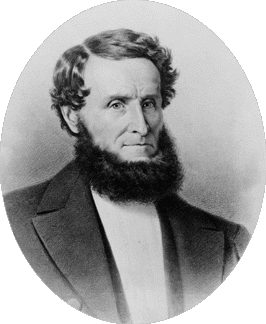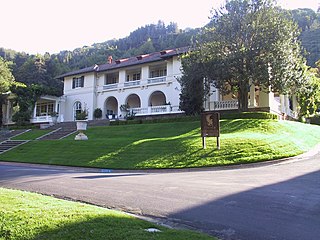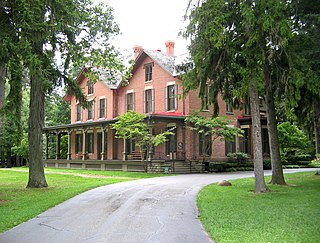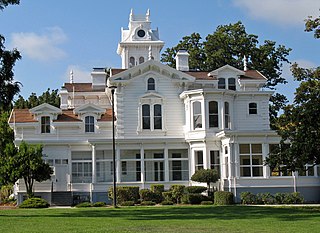
James Lick was an American real estate investor, carpenter, piano builder, land baron, and patron of the sciences. The wealthiest man in California at the time of his death, Lick left the majority of his estate to social and scientific causes.

The Montalvo Arts Center is a non-profit center for the arts in Saratoga, California, United States. Open to the public, Montalvo comprises a cultural and arts center, a park, hiking trails and the historic Villa Montalvo, an Italian Mediterranean Revival mansion nestled in the foothills of the Santa Cruz Mountains. The mansion and estate were constructed from 1912 to 1914 by California statesman and businessman James Duval Phelan. After Phelan's death, the entire estate was donated to California as a park and then a cultural and arts center as it exists today. The arts center maintains the estate in partnership with Santa Clara County. The mansion is a historic landmark, and in 1978 it was awarded inclusion in the National Register of Historic Places.

Ralston Hall Mansion located in Belmont, California, was the country house of William Chapman Ralston, a San Francisco businessman, a founder of the Bank of California, and a financier of the Comstock Lode. It is an opulent Italianate Villa, modified with touches of Steamboat Gothic and Victorian details. It is a California Historical Landmark and is designated a National Historic Landmark. It is now part of Notre Dame de Namur University.

Forbes Mill is a now-defunct flour mill originally built in 1854 located in Los Gatos, California, which served as the History Museum of Los Gatos after having been saved from destruction in 1982. The museum closed in 2014, and its collections are now part of New Museum Los Gatos. The building is currently owned by the city.

Spiegel Grove, also known as Spiegel Grove State Park, Rutherford B. Hayes House, Rutherford B. Hayes Summer Home and Rutherford B. Hayes State Memorial was the estate of Rutherford B. Hayes, the 19th president of the United States, located at the corner of Hayes and Buckland Avenues in Fremont, Ohio. Spiegel is the German and Dutch word for mirror. The traditional story is that the estate was named by Hayes' uncle Sardis Birchard, who first built it for his own residence. He named it for the reflective pools of water that collected on the property after a rain shower.

The Rengstorff House was one of the first houses to be built in Mountain View, California. It was built c. 1867 by Henry Rengstorff, a prominent local businessman who operated a ferry between San Francisco and Mountain View. It is built in the Italianate Victorian architecture style. The house's three-bay front facade features an entrance pavilion topped by a balustrade and a pediment on the middle bay.

The Conservatory of Flowers is a greenhouse and botanical garden that houses a collection of rare and exotic plants in Golden Gate Park, San Francisco, California. With construction having been completed in 1879, it is the oldest building in the park. It was one of the first municipal conservatories constructed in the United States and is the oldest remaining municipal wooden conservatory in the country. For these distinctions and for its associated historical, architectural, and engineering merits, the Conservatory of Flowers is listed on the National Register of Historic Places and the California Register of Historical Places. It is a California Historical Landmark and a San Francisco Designated Landmark.

Vanderbilt Mansion National Historic Site is a historic house museum in Hyde Park, New York, United States. Designated a National Historic Landmark in 1940, it is owned and operated by the National Park Service.
Greystone or Graystone may refer to:

New Almaden, known in Spanish as Nueva Almadén, is a historic community and former mercury mine in the Capitancillos Hills of San Jose, California, located at the southwestern point of Almaden Valley in South San Jose. New Almaden is divided into two parts: the mines and much of their immediate surroundings, including historic ghost town settlements in the Capintancillas, which together form the Almaden Quicksilver County Park, and the largely residential historic district surrounding the Casa Grande.

The Judah P. Benjamin Confederate Memorial at Gamble Plantation Historic State Park, also known as the Gamble Mansion or Gamble Plantation, is a Florida State Park, located in Ellenton, Florida, on 37th Avenue East and US 301. It is home to the Florida Division United Daughters of the Confederacy (UDC).

Le Petit Trianon is a historic mansion on the grounds of De Anza College at 21250 Stevens Creek Blvd. in Cupertino, California. The building now serves as the California History Center.

The Hayes Mansion is a historic mansion estate in the Edenvale neighborhood of San Jose, California. The mansion currently operates as a hotel resort and is currently known as Hayes Mansion San Jose, Curio Collection by Hilton. The hotel has been a member of Historic Hotels of America, the official program of the National Trust for Historic Preservation, since 2019.

Locust Grove is a National Historic Landmark estate located on US 9 in the Town of Poughkeepsie, New York. The 200-acre park-like estate includes homes, a carriage house, ice house, trails, a flower garden, and vegetable garden, and it overlooks the Hudson River from a bluff. The property includes a home designed by architect Alexander Jackson Davis for Samuel F. B. Morse, the inventor of the telegraph. An Italianate style mansion, it was completed in 1851.

Kimberly Crest House and Gardens is a French château-style Victorian mansion located in Redlands, California. The property is a registered California Historical Landmark and is listed on the National Register of Historic Places.

Belle Grove Plantation is a late-18th-century plantation house and estate in the northern Shenandoah Valley of Virginia, USA. It is situated in Frederick County, about a mile southwest of Middletown.

The Muckenthaler House, renamed the Muckenthaler Cultural Center, is a large Spanish Colonial Revival style residence built in Fullerton, California, in 1925.
Rancho Ulistac was a 2,217-acre (8.97 km2) Mexican land grant in present-day Santa Clara County, California, given in 1845 by Governor Pío Pico to Marcello and Cristobal, Indians. The grant extended across lowlands reaching from the Alviso shoreline southward and encompassing the land between the Guadalupe River and Saratoga Creek, and the town of Agnew.

The Meek Mansion is a historic mansion in unincorporated Cherryland, California, just north of Hayward. It is listed on the National Register of Historic Places. Located on nearly 10 acres, the Victorian house was built in 1869 by William Meek.



















